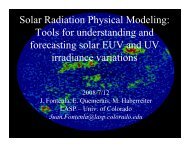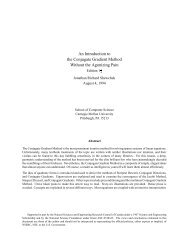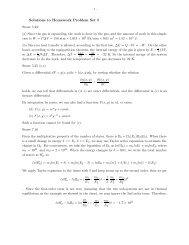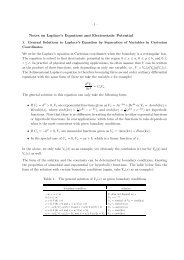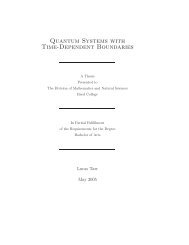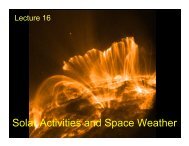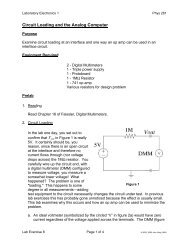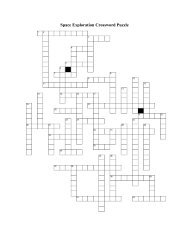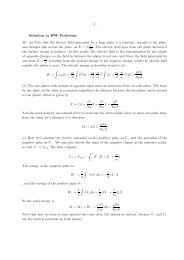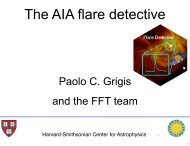The Topology of Magnetic Reconnection in Solar Flares
The Topology of Magnetic Reconnection in Solar Flares
The Topology of Magnetic Reconnection in Solar Flares
Create successful ePaper yourself
Turn your PDF publications into a flip-book with our unique Google optimized e-Paper software.
39null which shifts dur<strong>in</strong>g the flare toward one pole or the other. <strong>The</strong> direction the null shiftsdepends on the global configuration <strong>of</strong> the region; the underly<strong>in</strong>g doma<strong>in</strong> ga<strong>in</strong>s or losesflux <strong>in</strong> order to decrease the region’s energy state.<strong>The</strong> above explanation agrees with the observed footpo<strong>in</strong>t tracks and footpo<strong>in</strong>t separationspeeds <strong>of</strong> the three flares reviewed <strong>in</strong> this Chapter. Referr<strong>in</strong>g aga<strong>in</strong> to Figure 2.4,we propose the follow<strong>in</strong>g explanation for the footpo<strong>in</strong>t motions <strong>of</strong> flare A. As is <strong>in</strong>dicatedby the number <strong>of</strong> light grey field l<strong>in</strong>es drawn <strong>in</strong> doma<strong>in</strong>s P01/N14 and P01/N08, a largepercentage <strong>of</strong> P01’s flux is connected to N14 and N08. Initially, the footpo<strong>in</strong>t separationdistance decreases due to the reconnection <strong>of</strong> flux out <strong>of</strong> underly<strong>in</strong>g doma<strong>in</strong>s P01/N14 andP01/N08. <strong>The</strong> next stage <strong>of</strong> reconnection acts to release energy stored <strong>in</strong> the sheared arcade.Doma<strong>in</strong>s which have little connect<strong>in</strong>g flux <strong>in</strong> the earlier stage <strong>of</strong> the flare (P01/N11and P01/N10) fill up as reconnection takes place on higher and longer separators, and thefootpo<strong>in</strong>ts move apart from one another. An <strong>in</strong>-depth analysis <strong>of</strong> separator properties beforeand after flares will be given <strong>in</strong> a subsequent paper.Our model can be compared to other models that have been proposed to expla<strong>in</strong> HXRfootpo<strong>in</strong>t source motions. Bogachev et al. (2005) use a sheared 2.5D model to expla<strong>in</strong> theantiparallel motion <strong>of</strong> HXR footpo<strong>in</strong>ts along the neutral l<strong>in</strong>e. In their model, which cannotdist<strong>in</strong>guish between flares with <strong>in</strong>creas<strong>in</strong>g footpo<strong>in</strong>t separation from flares with decreas<strong>in</strong>gseparation, the apparent motions <strong>of</strong> HXR sources are determ<strong>in</strong>ed by the order <strong>of</strong> reconnectionalong the sheared system <strong>of</strong> field l<strong>in</strong>es. Dur<strong>in</strong>g the onset <strong>of</strong> a flare, the footpo<strong>in</strong>tsources move toward each other, decreas<strong>in</strong>g the distance between them, until a critical po<strong>in</strong>tis reached and the sources beg<strong>in</strong> to move away from one another. This model is similar toother models <strong>of</strong> reconnection <strong>in</strong> sheared arcades, where reconnection starts on the mosthighly sheared field l<strong>in</strong>es and progresses to the less sheared field higher <strong>in</strong> the corona. Aswas po<strong>in</strong>ted out earlier <strong>in</strong> this section, case 2 <strong>of</strong> our model is analogous to these modelswhere reconnection <strong>in</strong> sheared fields leads to the antiparallel motion <strong>of</strong> HXR footpo<strong>in</strong>t



